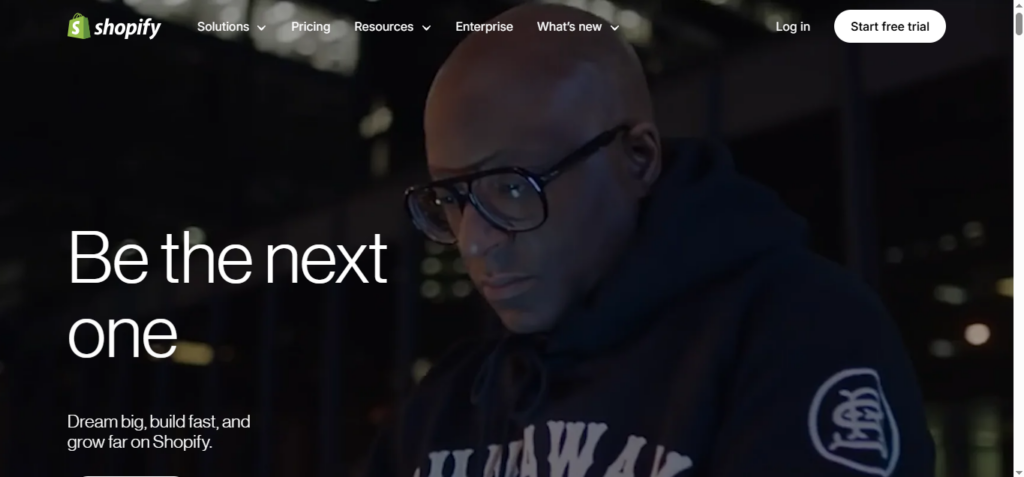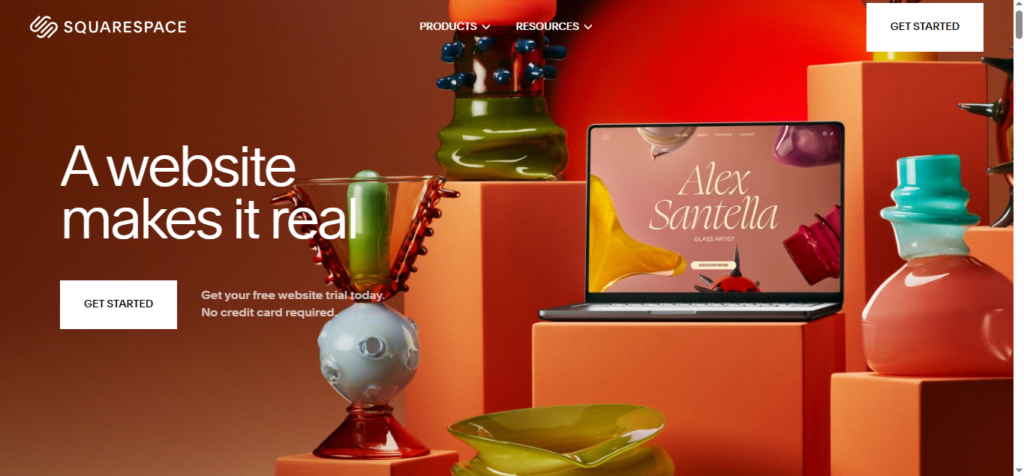So you’ve got a vision. You’ve got the products, the vibe, the aesthetic, the thing that makes your brand pop. Now you’re thinking: “Alright, it’s time. Let’s take this online.”
And guess what? You’re right on time.
Online shopping is blowing up, like, $6.9 trillion kind of big. By the end of 2025, that’s how much people are expected to spend online. It’s wild.
So yeah—if you’ve been waiting for a sign to start your store, this is it.
But here’s the part no one tells you: Picking a website builder matters. A lot.
It’s not just about throwing up some cute pics and adding a “Buy Now” button.
It’s about creating a space that feels like your brand.
A place that’s easy to shop, easy to manage, and honestly—just makes your life a whole lot easier.
Choose the wrong one? You’ll feel it fast.
We’re talking confusing tools, boring designs, tech headaches, and missed sales. No thanks.
That’s why we put this guide together—to help you skip the stress and find the website builder that works for you.
Whether you’re starting from scratch or giving your current store a glow-up, we’re here to help you build something that feels like you and sells like crazy.
Let’s talk about what matters when you’re choosing a builder for your fashion site.
What Makes a Fashion Website Builder Good?
Look, your site isn’t just a store. It’s your digital first impression. It’s your vibe. Your storefront. Your brand’s whole energy.
So you need a builder that gets that.
1. Templates
You know that feeling when you find the perfect outfit and it just gets you? That’s what your site should feel like.
Look for templates that are clean, bold, and easy to customize.
You want something that looks stunning right out of the gate, but also lets you tweak the colors, fonts, layout, whatever makes it yours
2. Photos That Hit Different
Fashion is visual. You need space to show off every angle, every detail, every little thing that makes your pieces pop.
That means big, high-quality images, zoom-in options, and even video.
Whether it’s a quick styling reel or a dreamy lookbook, your site should handle it, and still load fast. No one’s sticking around for a buffering screen.
3. A Shop That’s Smooth
If checking out feels clunky, your customers are gonna bounce. Plain and simple.
Your builder should make adding products, setting up size/color options, and handling payments effortless.
Oh, and stuff like abandoned cart recovery? Huge bonus. Because sometimes people get distracted, and your site should help bring them back.
4. Looks Good on Every Screen
Most people are shopping on their phones. Your site needs to look amazing and function flawlessly on every screen, big or small. Mobile-ready isn’t a feature anymore—it’s a must.
5. No Tech Stress
You’re a brand builder, a designer, a creator—not a coder.
Your website builder should be so easy to use that you can build your store in your pajamas with zero tech meltdowns. Drag-and-drop tools, simple dashboards, quick updates—done and done.
6. Marketing Tools
Building your store is step one. Getting people to find it? That’s where the real work starts.
A great builder helps with stuff like email newsletters, SEO (so you show up in searches), and linking up with your social media.
If you can post your latest drop straight to Instagram, even better.
7. Built to Grow With You
You’re not staying small forever, and your website shouldn’t either. Look for a builder that can scale with your brand.
More products? International shipping? Customer reviews? Pop-ups? Whatever you need down the road, your site should be able to handle it without starting over from scratch.
Top Website Builders for Fashion Stores in 2025
In 2025, your website is way more than just a place to sell things. It’s your brand’s front row, runway, and backstage all rolled into one.
It’s where your story lives. Where customers fall in love with your pieces. Where your brand’s voice, style, and mission get to take center stage.
But with so many options out there (and so many opinions on the internet), it’s easy to feel overwhelmed.
That’s where this guide comes in. We’re diving into 7 website builders fashion brands are using in 2025, what they’re great at, and what they’re not
#1. Olitt

If you’re at the beginning of your journey or you’re keeping things lean and simple, Olitt might be exactly what you need.
It’s kind of like that easygoing friend who just gets you. You don’t have to know how to code or even have a ton of tech experience.
You just hop on, pick a template, drag-and-drop your stuff into place, and you’re up and running.
What makes Olitt great is how low the barrier to entry is. You don’t need to spend thousands, or even hundreds, to get started.
For small fashion brands, solo designers, or creative hustlers building their brand from scratch, that’s a game-changer.
Why you’ll vibe with Olitt:
- It’s super beginner-friendly.
- There’s a free plan, and even the paid plans are affordable.
- It gives you all the basics you need to sell: product pages, payments, inventory, the works.
- You can go from idea to live site in a day if you want.
What to keep in mind:
- It’s not built for big, complex stores. If you’re planning to scale fast, you might outgrow it.
- The design library is small, and customization is pretty limited, so it’s great for clean, minimal stores, but not for super bold or highly branded designs.
- It’s missing some of the advanced features that platforms like Shopify and BigCommerce offer. But if you don’t need those yet, you’re golden.
#2. Shopify

Shopify is the name in e-commerce for a reason. It’s reliable, endlessly scalable, and packed with features.
It’s also got a massive ecosystem of apps, partners, and integrations, which means you can do a lot with it.
But with great power comes… a bit of a learning curve (and a price tag to match).
Why Shopify is loved by fashion brands big and small:
- It gives you everything: inventory management, shipping, marketing tools, abandoned cart recovery, analytics—you name it.
- There’s an app for everything. Want a virtual fitting room? A loyalty program? Shopify’s got options.
- It’s made for growth. You can start small and scale up without switching platforms.
- Your store looks good on any screen and is optimized for Google search right out of the gate.
Some things to think about:
- It’s not the cheapest option. As your business grows, so do your costs—especially if you’re adding apps or upgrading your plan.
- Shopify charges transaction fees unless you use their payment system, so factor that into your pricing.
- It can feel overwhelming at first. The dashboard has a lot going on.
3. Squarespace

Imagine walking into the kind of boutique that has minimalist lighting, soft music, and artfully arranged racks, and you just feel cooler for being there.
That’s what Squarespace feels like.
It’s known for stunning design, clean templates, and a design-first approach that fashion brands love.
If your brand leans more editorial, high-concept, or aesthetic-forward, this could be your perfect match.
What makes Squarespace so appealing:
- The templates are gorgeous. Sleek, modern, and ideal for visual storytelling.
- It’s super easy to use—perfect for creatives who want to build something beautiful without touching code.
- It’s an all-in-one platform: hosting, domain, email, and marketing tools are all baked in.
- It’s great for building a brand, not just a store.
What’s not so great:
- There’s less flexibility. If you want total design control or lots of third-party apps, you might feel a bit boxed in.
- It’s pricier than some alternatives, especially for more robust e-commerce features.
- It’s not as scalable or feature-rich as Shopify or BigCommerce if you’re planning to grow fast.
4. Wix

Wix is like the scrappy creative partner who says, “You dream it, we’ll build it.”
It’s wildly flexible and gives you full creative control over how your site looks and functions.
For fashion brands that want to stand out visually and don’t mind tinkering a bit, Wix is a fantastic choice.
What’s great about Wix:
- Tons of templates, including lots customized to fashion and lifestyle brands.
- The drag-and-drop builder is super intuitive—you can build anything you imagine.
- Massive app market to extend your site’s functionality.
- Pricing is competitive, with plenty of options depending on what you need.
Things to be aware of:
- You can do a lot, but that also means you can go overboard. Too many apps or elements can slow your site down.
- It’s not always the smoothest at scale. If you’re planning to grow fast or have a large product catalog, Shopify or BigCommerce might be better.
- SEO and performance can take a bit of extra effort to optimize.
5. BigCommerce

BigCommerce is built for serious growth. If your fashion brand is scaling fast, selling on multiple platforms, or going international, this is the kind of platform you want backing you up.
It’s not the easiest to learn, but it’s packed with tools to help you run a high-performing, multi-channel business.
What makes BigCommerce stand out:
- Advanced tools for SEO, analytics, and sales across marketplaces like Amazon, eBay, and social media.
- It’s built to scale—bring on the SKUs, traffic, and complex logistics.
- Many features are included natively, so you don’t need to rely on tons of third-party apps.
Where it might fall short:
- It’s more technical than platforms like Wix or Squarespace. If you’re not super tech-savvy, there might be a steeper learning curve.
- Design flexibility isn’t as strong. You might need a developer to get things just right.
- The pricing can be a bit much for smaller or early-stage brands.
6. WordPress.org (with WooCommerce)

Okay, so this one’s for you if you love the idea of building something totally your own.
WordPress with WooCommerce is kind of like getting an empty boutique and decorating it exactly how you want, from the wallpaper to the hangers.
It gives you tons of freedom, but you’ve got to be ready to roll up your sleeves a little.
Why you might vibe with it:
Full creative freedom: Seriously, you can customize just about everything.
Your site can look and work however you want it to.
There are so many add-ons that there’s one for nearly anything. Want a fancy size chart? A try-on tool? A live chat? You name it, and it exists.
You control the costs: You can begin small and progress when you’re ready. It’s quite budget-friendly.
But, here’s the real deal:
There is a learning curve: Setting things up is difficult unless you are already technically savvy or know someone who is.
It needs TLC: You’ll have to keep an eye on updates, security, and little fixes along the way.
It takes time: If you’re in a hurry or don’t love fiddling with tech stuff, this route might feel a little overwhelming.
7. GoDaddy Website Builder

Now, if you’re just trying to get your fashion brand online without getting lost in the weeds, GoDaddy’s Website Builder is like the fast-food version of web design—in a good way.
It’s quick, simple, and effective when all you want to do is get started.
Why it may be ideal for you:
So simple: Even if you’ve never worked with a website before, you can set up your business in one day.
Budget-friendly: Perfect for small businesses or side hustles that don’t demand a large initial investment.
Useful tools include: Built-in marketing options, making it simple to send emails and link to your social media accounts.
What to consider:
It’s fairly simple: if you have a highly specific idea or want fancy extra features, this builder may feel limited.
You could outgrow it: Perfect for starting, but if your brand blows up (fingers crossed!), you might need to upgrade to something more powerful later.
So… How Do You Pick?
Here’s the thing: there’s no perfect platform—just the one that fits you best right now.
Ask yourself:
How much do I want to spend? Some platforms are practically free, others cost more but offer more too.
Do I want full creative control, or just something that works?
What’s my vibe—DIY or done-for-me?
Am I okay learning a few techy things, or is that a hard no?
Can this platform grow alongside me, or will I have to move later?
Conclusion
If you’re just starting and want to keep things simple, companies like GoDaddy or Olitt are ideal for getting your business online without hassle.
However, if you want complete control over the appearance and features of your shop, WordPress with WooCommerce or even Shopify may be better options.
You’ve got it. Your store doesn’t have to be perfect on the first day.
Begin where you are, grow as you go, and make modifications as needed. What’s most important? Simply start.

